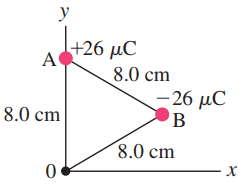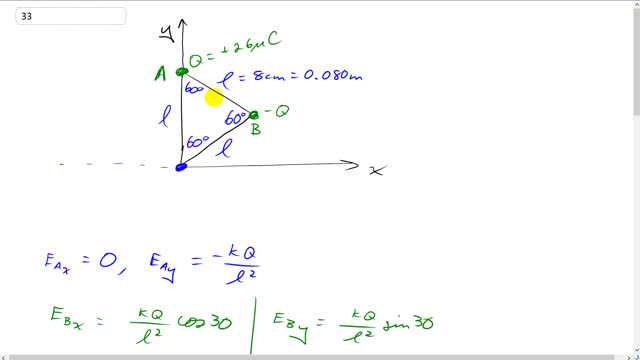
Determine the electric field at the origin 0 in Fig. 16–58 due to the two charges at A and B.


In order to watch this solution you need to have a subscription.
This is Giancoli Answers with Mr. Dychko. We need to find the electric field here at the origin of this coordinate system where you have x positive to the right and y positive upwards. And we have an equilateral triangle which means all sides are of equal length, eight centimeters or 0.08 meters and there's a charge plus 26 micro coulombs on the y axis here and a charge of positive or negative… Negative of the same magnitude. So negative 26 micro coulombs, here at position B and the electric field at the origin will be the vector sum of the electric fields due to each of these points. And let's consider the point A first and the x component of the electric field due to Point A is the easiest part of this whole question and that's zero because the electric field due to Point A is straight down, it has no component horizontally. And the y component to the electric field due to the point charge A is gonna be just electric field due to a point charge, no trigonometry needed because it's all straight down. So that's gonna be negative k q over l squared and I put a negative sign there because it's going downwards and we're always putting magnitudes of charge into our formulas here and taking care of negative signs outside. Like right here instead of putting in positive and negative into the charge we're always using magnitudes of charge and we can see this directed downwards and that's the negative direction. Okay then we have charge B. Since it's negative in the electric field due to charge B is gonna be this direction that's electric electric field due to B along the line connecting charge B with this point of interest at the origin we can make a triangle over here to show this in more detail. So here is E B, electric field due to charge B and it's gonna have some x component E B x and some y component straight up, E B y. And since this is 60 degrees because those inside an equilateral triangle, all three angles are 60 degrees. If that's 60 and this is 90 between the axes, that leaves a 30 left over here. So 90 minus 60 makes 30. So in this triangle here I have 30 degrees and that makes the x component equal to the electric field strength E B times Cos 30. Here’s Cos 30 times the hypotenuse to get this adjacent leg here. And E B is k Q over l squared and then multiply by cos 30 and cos 30 comes out of the special triangle if you want to have fancy exact answers one, two, root three, 30 degrees 60 degrees cos 30 is root three over two. And then the y component of electric field due to point B will be k Q over l squared times sine 30. Because it's the opposite leg that we're trying to find and sine 30 is one half. And so we have k Q over two l squared. And then and now the x component of the resultant electric field is going to be just the x component of the field due to B because the field due to A has no x component at all. So it's just gonna be square root three k Q over two l squared. Just copying this here. And then the y component is going to be the y component due to the charge B upwards. So it's positive then minus the y component due to charge A which is downwards, so its negative. So, that’s k Q over l squared and multiply top and bottom by two here and to make a common denominator of two l squared and we get one minus two which is negative one, so negative one k Q over two l squared is the y component of the resultant electric field and then add those components together using Pythagoras to get the magnitude of the resultant and that gives a square root of E x squared. So that's root three over two times k Q over l squared, all squared, plus the y component of the resultant, negative k Q over two l squared squared. And this k Q over two l squared can be factored out and since it's squared it just becomes k Q over two l squared outside the square root side and then multiply by the square root of whats left over. So we have a root three squared plus negative one squared which makes three plus one which is square root four, which is two and the twos cancel leaving us with k Q over l squared is the magnitude of the resultant. Now we can see this since the y component is negative and the x component is positive that our electric field is going to be down into the right, y component negative x component positive. So when we take the inverse tangent of the y component divided by the x component we're finding this angle theta which is below the positive x axis and so let's do that now we'll take the inverse tangent of the y component divided by x component which is the y component multiplied by the reciprocal of the x component, that's a nicer way to do this so we can see how things cancel. So the y component was k Q over two l squared just using magnitudes because we've already taken care of direction by drawing that picture there and then multiply by the reciprocal of the x component and so that's two l squared over root three k Q and lots of things cancel conveniently leaving us with one over root three and that's our special triangle again. This is 60. This is 30. So the inverse tangent of one over root three is 30 degrees. And so our answer is, electric field is k Q over l squared, 30 degrees below the positive x axis.
Hi,
Could you explain why you used 30 degree angles instead of 60?
Thank you.
Hi ctlawson, as part of our job in this question we need to break the electric fields into 'x' and 'y' components. It would be perfectly OK to use . The difference is that you would have to think about which trig. function is the right one to use. For example, when I calculate using you could instead use . It's just a matter of personal preference.
Cheers,
Mr. Dychko
Thank you, Mr. Dychko.
Thanks very helpful
I need 16-58, pls